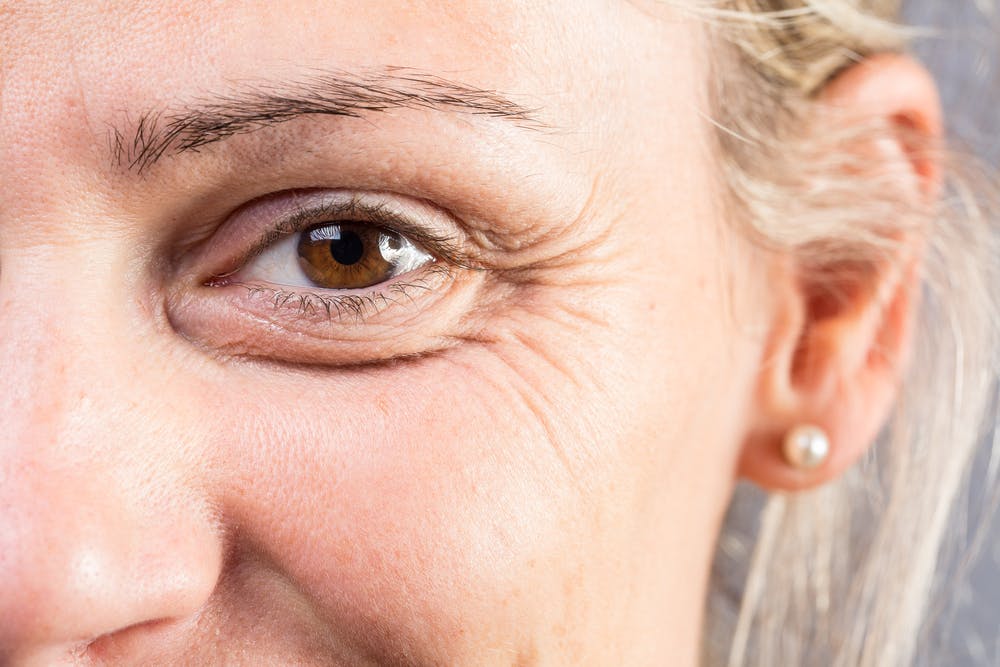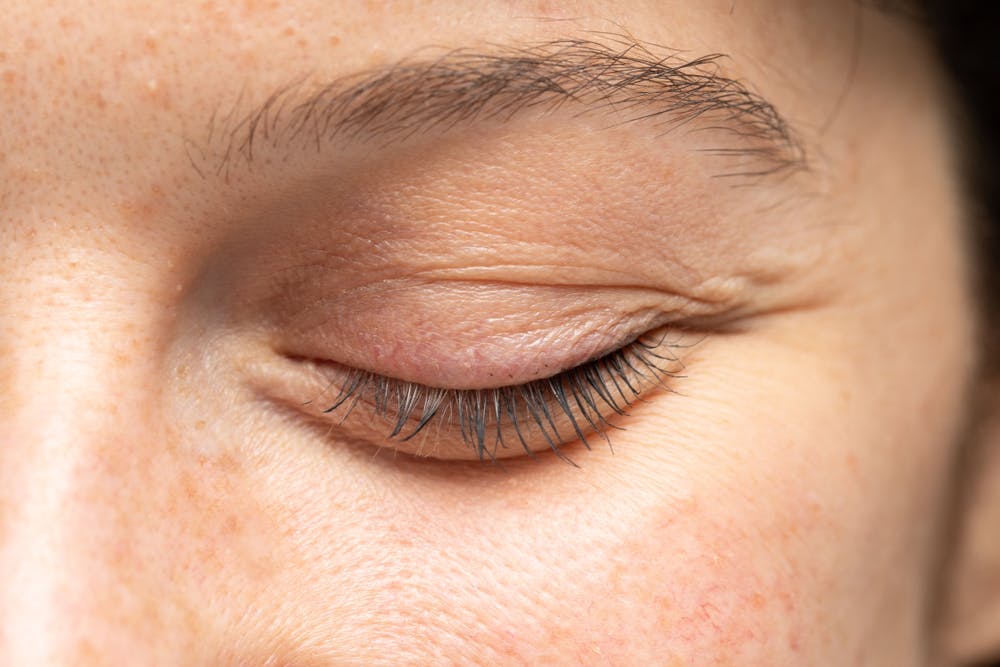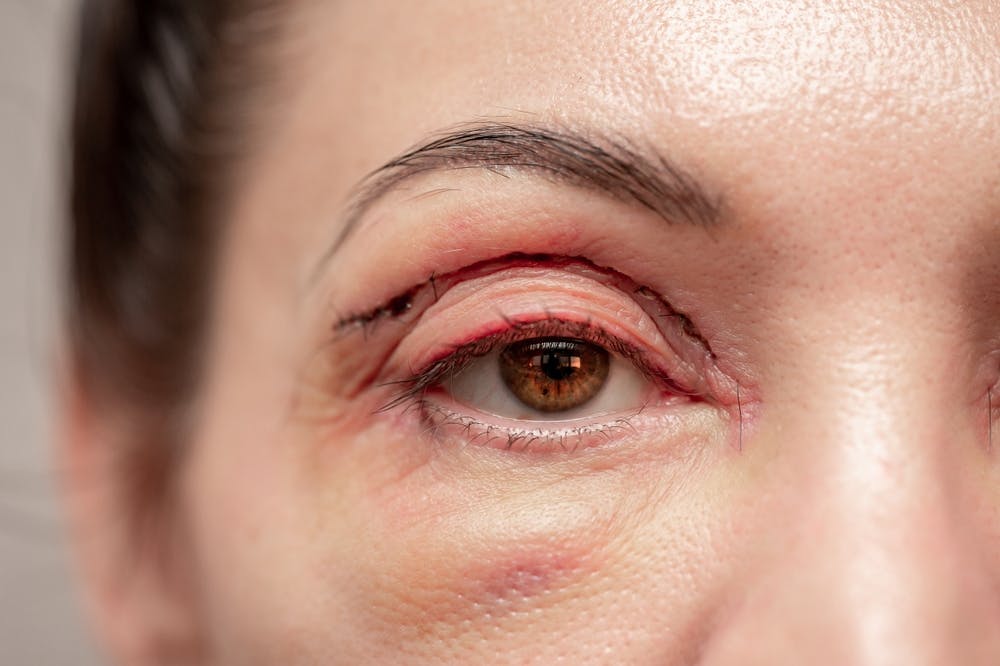
Blepharoplasty is a procedure that enhances the appearance of the eyes by addressing issues such as under-eye bags and sagging eyelids. It can also potentially improve vision by correcting excess skin or sagging upper eyelids that obstruct the field of vision and can even interfere with peripheral vision.
Despite its many benefits, blepharoplasty comes with the risk of complications, like any cosmetic surgery procedure. Read on to learn more.
Understanding Potential Complications in Blepharoplasty
Blepharoplasty, like all cosmetic procedures, carries potential risks and complications. These can range from minor complications to more serious ones, and understanding these potential issues is crucial for patients considering this surgery.
The risks of blepharoplasty include:
- Temporary dry eyes or blurred vision
- Temporary eyelid problems, such as difficulty closing the eyes or droopy eyelids
- Visible scarring
- Injury to eye muscles
- Temporary pain, redness, or swelling
- The need for follow-up revision surgery due to complications or unsatisfying results
There can be serious complications, such as loss of vision due to retrobulbar or orbital hemorrhage, although this is very rare.
Preventive Measures: Mitigating Complication Risks
To prevent blepharoplasty complications, a comprehensive patient consultation is the first step. This involves:
- A detailed clinical history to assess potential risks before the procedure.
- Consideration of all medical conditions, including vascular diseases and eye conditions, to determine if the surgery will be safe for the patient.
- A thorough examination of the patient’s eyes to ensure there is no infection, eye disease, or other significant eye issues.
- Noting any pre-existing asymmetry and including it in the surgical planning.
Preoperative care is essential, and blepharoplasty patients are advised to strictly follow all instructions to ensure a safe procedure

Immediate Post-Operative Concerns: Early Identification
In the immediate aftermath of a blepharoplasty procedure, patients may experience a variety of symptoms, including:
- Blurred vision or double vision: These visual disturbances are common and usually improve within a couple of days after surgery. However, if these symptoms persist or worsen, it could indicate a more serious issue, such as optic nerve ischemia or injury, and should be reported to your surgeon immediately.
- Dry eyes: This is a common complication of blepharoplasty and can be managed with prescribed eye drops. Persistently dry eyes, however, may require additional intervention.
- Redness, bruising, and swelling: To manage these symptoms, patients are advised to use ice packs on their eyes for 10–15 minutes every three hours for the first 48 hours post-surgery.
- Discomfort: Mild discomfort is expected in the days after surgery. Persistent or increasing pain could be a sign of infection or other complications and should be reported to the surgeon immediately.
Navigating Swelling and Bruising: Early Management
Swelling and bruising are common complications of blepharoplasty. These symptoms typically appear a couple of days after surgery and are part of the body’s natural response to the surgical procedure.
To manage these early postoperative complications, patients are advised to:
- Use ice packs on their eyes for 10–15 minutes every three hours for the first 48 hours. This can help reduce swelling and bruising by constricting the blood vessels and reducing blood flow to the area.
- Sleep with their heads elevated at least 45 to 60 degrees for a few days. This can help reduce swelling by promoting fluid drainage from the face.
- Avoid bending forward, which can increase blood flow to the face and exacerbate swelling and bruising.
Most patients can return to work 1-2 weeks after the blepharoplasty procedure. However, they should avoid vigorous activity and strenuous exercise for at least a week after eyelid surgery. Rubbing eyes or wearing contact lenses should also be avoided until your facial plastic surgeon indicates it’s safe.
Addressing Wound Healing Issues
Post-blepharoplasty wound healing is a critical aspect of recovery. This typically includes using prescribed eye drops or ointments, keeping the eyelid skin clean, and avoiding rubbing or touching the eyes.
Issues with wound healing can arise after a blepharoplasty procedure. These can include wound dehiscence (opening), scar abnormalities, or infection. Mild dehiscence may be addressed with antibiotics, while full dehiscence needs to be repaired. This is a rare situation.
Scarring is evaluated at each follow-up appointment, and patients might be asked to massage the area and use vitamin E cream.
Patients should also be vigilant about any changes in visual acuity, bleeding from the incision, or loose or open incisions. Also, watch for signs of infection, such as persistent or increasing pain, warmth or redness, fever, or pus oozing from the incision.
Eye-related Concerns: Protecting Visual Health

Post-blepharoplasty, safeguarding visual health is a significant consideration. The surgery carries a risk of temporary or even permanent vision loss due to rare occurrences of retrobulbar or orbital hemorrhage. Other visual impairments, including double vision or blurry vision, may intermittently occur during the recovery period.
To ensure visual health, consider the following recommendations:
- Wear dark sunglasses to protect the eyes from sun and wind exposure.
- Refrain from activities that may strain the eyes, such as reading or screen time, for several days after surgery.
Regular follow-up appointments with the surgeon are essential to monitor visual health and promptly address any concerns
Long-Term Complications and Persistence: Monitoring and Management
Long-term complications can also arise after blepharoplasty. These can include persistent swelling, dry or irritated eyes, difficulty closing the eyes, noticeable scarring, or injury to eye muscles. If these complications persist, it’s important to seek professional guidance.
In some cases, additional surgical or non-surgical interventions may be required to correct or manage these issues.
Professional Guidance and Intervention
In the event of a complication following a blepharoplasty procedure, immediate consultation with the surgeon or a healthcare professional is essential.
Prompt identification and treatment of any issues can greatly enhance the outcome and reduce the likelihood of complications escalating.
Skilled plastic surgeons are equipped to offer a range of interventions, from providing reassurance and conservative management to performing surgical revisions.
Holistic Recovery: Comprehensive Aftercare
The journey to recovery is multifaceted and includes the following:
- Emotional Well-Being: The aftermath of any type of surgery, including blepharoplasty, can trigger a range of emotions. Clear communication about the expected recovery process, potential complications from the eye surgery, and the timeline for results can help manage these emotions.
- Nutrition and Hydration: A balanced diet rich in nutrients supports the body’s healing processes after surgery. Proper hydration is also vital in facilitating recovery.
- Activity Modification: Guidance on when and how to resume normal activities, including exercise, is essential to prevent complications such as orbital hemorrhage or posterior capsule ruptures.
- Sleep and Rest: Sufficient sleep and rest are crucial for optimal recovery. In the days after surgery, patients should sleep with their heads raised at least 45 to 60 degrees and avoid activities that can strain the eyes, such as reading or looking at a screen.
- Eye Care: Patients should wear dark sunglasses to shield their eyes from bright lights and wind. Regular follow-up appointments with the surgeon are crucial to monitor visual health and address any visual disturbances, such as blurred vision, double vision, or a prompt loss of vision.
Proactive Approach to Managing Blepharoplasty Complications
Adopting a proactive approach to managing blepharoplasty complications can significantly improve the outcome of the procedure. This starts with choosing experienced surgeons in blepharoplasty and having a thorough consultation.
It is important to understand the potential risks, take preventive measures, and be vigilant about the early identification and management of complications.
Finally, strict adherence to your surgeon’s pre-and post-operative instructions will go a long way in eliminating or minimizing complications in the long run. If you have any more questions, schedule a consultation today with Glasgold Group expert facial plastic surgeons.



